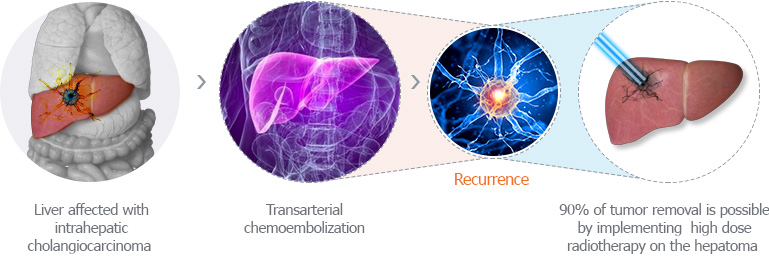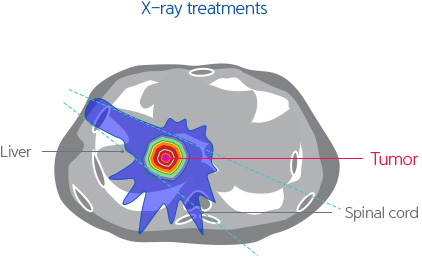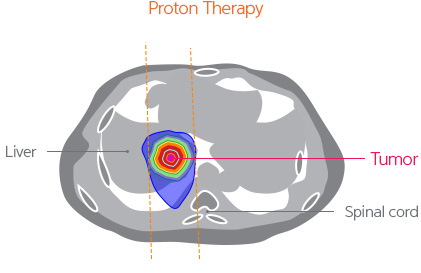
Proton therapy for liver cancer
We would like to introduce the details of proton therapy for liver cancer.
- 01.
- Which situations can proton treatment be applied to treat liver cancer?
- Liver cancer which cannot have surgical operations or high frequency cauterization applied (liver cells cancer)
- Liver cancer with hepatic portal thrombosis (liver cells cancer)
- When there are no effects after implementing the chemoemboliza to the hepatic artery
- When surgical operation cannot be applied to the liver biliary cancer


- 간내담도암에 걸린 간
- 간동맥화학색전술
- 재발
- 간세포암에 대한 고선량 방사선치료 시행할 경우 90% 종양제거 가능
* When the X-ray treatments transfers high dose radiation, it exposes an excessive level of radiation to the surrounding organs
- Proton therapy only transfers high dose radiation to the treatment site
- [FAQ] What is “High Frequency Cauterization?”
-
- It is a treatment method for necrosing cancer tissues by generating heat with a high frequency current after inserting a fine needle electrode to the cancer tissue while monitoring the echogram. By applying the high frequency current to the biological tissues, the status of the ions in cells will be varied between positive and negative poles, 0.4-0.5 million times for a second. This treatment method utilizes the principle of necrosing the cells by heating in this process. It applies to approximately 10% of patients, from the entire liver cancer treatment methods. It has the advantage of treating patients with decreased liver function.
- [FAQ] What is the range of liver cancer?
-
- Liver cell cancer makes up the highest proportion of 80-90% of all liver cancer among primary malignant tumors which occur in the liver tissue. Cholangiocarcinoma which occurs in the intrahepatic bile duct accounts for about 10~15% of the proportion and angiosarcoma is included in the liver cancer category. However, hepatocellular cancer is generally referred as liver cancer.
- 02.
- What is the advantage of liver cancer patients being treated with the proton treatment?
-
In the case that surgical operation is difficult to implement, proton treatment demonstrates higher tumor control rates compared to the existing treatment.
When hepatocellular cancer cannot be treated through surgical operation, it is generally treated with hepatic arterial chemotherapy. However, it has been reported that over 60% of the patients experience recurrence in the treated site within 6 months. It has been reported in many dissertations that a removal rate of over 90% can be achieved when hepatocellular cancer is treated through radiotherapy with a high dose of radiation.
-
Without a decline in liver function, high tumor control rate cannot be expected.
When hepatocellular cancer is combined with hepatitis B, C, or liver cirrhosis caused by drinking alcohol, maintaining liver function is critical during the treatment period. In the X-ray treatments, reducing the radiation dose to protect the liver function or just bearing the side effects were inevitable. However, proton treatment can deliver a high dose radiation to the cancer tissues selectively while minimizing the exposure of radiation to the normal peripheral liver. Therefore, higher tumor control rate can be achieved without decreasing the liver function. Similarly, in the case of hepatobiliary cancer which cannot be applied to surgical operations, it is expected to increase the tumor control rate and overall survival by implementing proton treatment.

 [Proton Therapy compared to the X-ray treatments to treat liver cancer]
[Proton Therapy compared to the X-ray treatments to treat liver cancer]
- 03.
- What are the effects of the treatment?
-
When implementing proton treatment for liver cancer, higher treatment reaction rates and tumor control rates of more than 90% can be achieved, while the liver function does not decrease and the side effects of the stomach and bowel have not increased compared to the other treatment methods. It was reported that similar results can be drawn for the patients who cannot or had to undergo surgical operations through various prospective studies* and large numbers of retrospective studies*.
Moreover, when compared to X-ray treatments, it was confirmed that the tumor control rate and overall survival were higher and the side effects were lower for proton treatment.* Prospective Studies: Follow-up the subjects in present times.
* Retrospective Studies: Investigate the subjects prior to the present times.
[Entire Hepatocellular Cancer]
Entire Hepatocellular Cancer General X-Ray Treatment Radiation Surgery for an Orthotopic Body with X-Ray Proton Treatment tumor control rate 50~70% ≥ 85% ≥ 85% Side Effects Occurrence Rate 5~20% 5~10% 2~5% Overall Survival for 3 Years 25% About 60% About 60% ※ Measurement can be varied according to factors such as the characteristics of the patient.
[Hepatobiliary Cancer]
Hepatobiliary Cancer X-ray treatments Proton Treatment Median Survival Period * 8 - 17 months 27.5 months ※ Measurement can be varied according to factors such as the characteristics of the patient.
-
In the case which hepatobiliary cancer cannot be treated with surgical operation, the median survival period* is reported as 27.5 months when every tumor is included in the range of proton treatment.
* Median Survival Period: The period where half of the patient population survives



